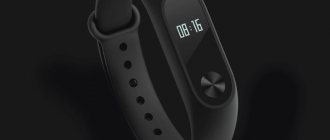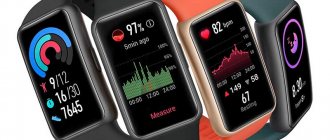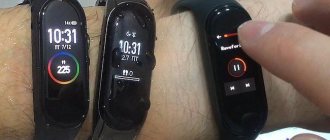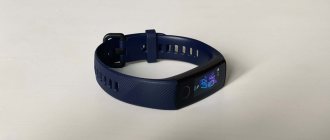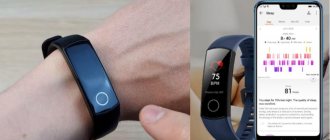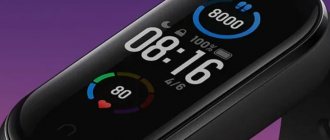I can call myself a fan of the Mi Band series of fitness bracelets from Xiaomi. I have already used three of the company's trackers, each time purchasing them immediately after the premiere. This equipment accompanies me literally 24 hours, in the pool, while sleeping, at work, at university and while jogging. I became so attached to this gadget that, after selling my Mi Band 3, for several days, while I still didn’t have the “four,” I experienced great discomfort. So I waited for the new Xiaomi Mi Band 4 with longing and high demands.
Buy Xiaomi Mi Band 4 on AliExpress” https://bit.ly/2YPmrv0″]View[/button]
Buy Xiaomi Mi Band 4 with NFC on AliExpress” https://bit.ly/2GdHro2″]View[/button]
Did the new Mi Band 4 sports bracelet from the popular Chinese manufacturer live up to my expectations? Find out from this review.
Characteristics of Xiaomi Mi Band 4
| Display | 2.5D AMOLED, 0.95-inch (120×240 pixels), 400 nits brightness |
| Waterproof | up to 5 atm / 50 m |
| Sensors | Accelerometer (triaxial), gyroscope (triplex) and pulse (optical) |
| Synchronization | Android and iOS |
| Connection | Bluetooth 5.0 |
| Battery | 135 mAh Li Ion, autonomy: 20 days (according to the manufacturer) |
| Size and weight | Width 18 mm, adjustable length from 155 to 216 mm, 22 grams |
| In the box | Mi Banda 4 with strap, USB cable with charging adapter and instructions |
| Price | From 2 thousand rubles |
On the box and on the manufacturer’s website this device is listed under the name Mi Smart Band 4. However, most stores, portals and users still use the name Xiaomi Mi Band 4 - which is what I titled this review with.
Connecting to a smartphone
The bracelet itself cannot work, so it must be paired with a tablet or smartphone. For pairing, a proprietary application from Xiaomi called Mi Fit is usually used. You can also use some third-party apps like Mi Band Master, but the official app is still Mi Fit.
The application is free and available for download both in the Play Market (for ANDROID) and in the AppStore (for iOS). You can download Mi Fit for ANDROID at this link: https://play.google.com/store/apps/details?id=com.xiaomi.hm.health, for iOS at this link: https://apps.apple. com/ru/app/mi-fit/id938688461. You can also find the application in stores by name or by scanning the QR code from the image below.
If you already have the Mi Fit application installed, you should update it, since the Russian translation appeared only in version 4.0.5.
After installation, launch Mi Fit. Then you should log in to the application or register if you do not have a Mi Fit account yet. You can register an account via phone number or email. The registration process is very simple and should not cause any difficulties for anyone. You just need to follow the prompts. You can also log into the application through your Google or Facebook accounts.
After authorization, you need to link the bracelet to the application. To do this, click “+” in the upper right corner of the screen, then select “Bracelet”, agree to the notification about collecting statistics and select our device from the list. After this, a connection occurs, which will need to be confirmed by touching the icon on the bracelet screen after vibration.
Next, the application will check the firmware version and automatically update it to the latest version. The update takes place in several stages: first the firmware is updated, then the resources, then the fonts. After this, the device interface will automatically be translated into the smartphone language, regardless of the version of the fitness bracelet (Chinese or global). That’s it, now you can move on to the settings, but first let’s go through the device interface.
Appearance and build quality
At first glance, it is clear that not much has changed in terms of appearance from the Mi Band 3. And that's good, because I liked the design of the previous Xiaomi bracelet; it's simple, even minimalistic, but not as cheap as some of its competitors.
On the front side, the quality of the materials makes a good impression, as does the 2.5D glass (which, however, mercilessly collects fingerprints). On the back there is also high quality plastic. On the plus side, the bands from the previous bracelet model will be compatible with the Mi Band 4, so we have access to a database of thousands of Band 3 designs and colors.
What's new
The software on the Mi Band 4 is a proprietary operating system that does not have its own name. Among the new functions, the bracelet now has the ability to control music turned on on the smartphone, custom watch faces (more on them later), as well as the ability to enable workouts directly from the bracelet itself.
In the “Advanced” menu, it is now possible to turn on alarms and set a timer. Alarms are created on a smartphone.
I should note that there is no built-in GPS in the Mi Band 4, so to track your distance when running or cycling, you need an active connection to your smartphone via Bluetooth. By the way, the device uses the Bluetooth 5.0 protocol, which means that the bracelet will save battery power. But only if the smartphone you are using in conjunction with Mi Band 4 has the same version of the “blue tooth”.
The supported modes for tracking training indicators in the bracelet include: outdoor running, treadmill, bicycle, walking, strength exercises and swimming pool.
I tested the bracelet while lifting a barbell and I can say that it does not count the number of lifts, however, you can see your heart rate and calories burned (I think the value of calories burned should hardly be taken seriously, but still). The pulse was measured quite accurately. By placing my finger on the artery, I counted 114 beats, and the bracelet showed 110. In addition to the test in a small strength training session, I also tested the Mi Band 4 on a bike ride. More on the results below.
Fitness tracker screen
The Xiaomi Mi Band 4 screen deserves a separate paragraph. This is where the biggest changes have taken place compared to its predecessor. Visibility has increased significantly, but this has not made the bracelet larger; it is still far from the size of a smartwatch. It is important to note that the monochrome screen has been replaced with a colorful and bright AMOLED with a higher resolution.
This opened up access to completely new screensavers, of which there are quite a few, although I liked a few, but this is a matter of taste. I hope that over time there will be more of them, and maybe Xiaomi will figure out some simple editor for watch faces. But let's go back to maximum brightness, because this is probably the biggest problem with the predecessors of the Mi Band 4. Finally, when you go outside on a sunny day, you don't need to cover the tracker's display with your hand to see a notification or the time - 400 nits does the trick case.
I also feel like the updated band is more responsive to touch, but that could be due to the larger display. I'm glad that the selection of screensavers has become really wide, there should be something for everyone here.
Specifications
Huami's Huangshan No.1 quad-core processor is designed for use in smartwatches. It is characterized by high performance and is equipped with artificial intelligence (sensors for measuring pulse, heart rate anomalies). At the same time it consumes a small amount of energy.
The use of Always on technology allows you to increase operating efficiency by almost 40% compared to chipsets based on Cortex-M4 cores.
Equipment
The Mi Band 4 fitness bracelet comes in a rectangular cardboard box. One half of the cover is white, with an image of the device and the brand logo, the other is black, with the original image of the model number. The bracelet comes with:
- Charging station
- Adapter cable
- Strap
- User manual
The global version of the instructions has a section in Russian.
Design and ergonomics
The design of the Mi Band 4 fitness tracker differs slightly from other versions, although you can only notice the difference upon careful examination. The capsule is made of durable matte plastic. Therefore, there are no fingerprints left on it. The display size has increased by 40% compared to Bend 3. But now it began to stand out against the background of the capsule body. The front panel has become flatter. There are no mechanical buttons on the capsule. The touch button is not concave, as in the previous version, but flat. Its location is indicated by a special icon: a circle or É.
The hypoallergenic rubber strap is smooth and has a soft-touch coating. Its length is adjustable within 15.5-21.6 cm. There are 12 holes along the entire length of the strap, so it is suitable for hands of any thickness, both male and female. Standard strap colors are black, red, blue. But you can buy it in a different color. Straps from earlier models will fit.
The contact base is located at the bottom of the capsule; to charge it, you need to remove it from the strap. Capsule dimensions 17.8×46.8 mm, thickness 12.6 mm. Weight 22 g. The capsule is securely installed in the bracelet body and does not fall out. The strap fits snugly to the hand, does not pinch or interfere. The bracelet is light and compact, you can use it while playing sports and sleep with it comfortably.
Features and Features
All functions from Mi Banda 3 have been transferred to the “four”. The use of the bracelet is based on almost identical gestures as its predecessor. This is correct, because control over the gadget here is very precise and intuitive. Some functions have been expanded in relation to its predecessor, so now, for example, we can start the alarm from the wrist and no longer need to open the application on the phone. Small thing, but convenient, I use it often. It's also worth mentioning the addition of a handy timer.
The heart rate monitor, as in previous models, is surprising in its accuracy when we compare it with a device in the same price category. One of the errors that I encountered was that one day, Mi Band 4 did not count my steps, only after re-synchronization everything returned to normal.
The biggest (in my opinion expected) new feature in Xiaomi Mi Band 4 is the ability to control music from the tracker level. Once we unlock the bracelet, we can go to the music control application using the right or left drag gesture. With this function we can conveniently change the song to the next or previous one, stop the music or change the volume. For me this is a big advantage along with the screen.
Mi Band 4 features include: Weather, heart rate monitor, alarm clock, music control, stopwatch, timer, smartphone search, sleep tracking, sports activities, notifications (the tracker can recognize when we are sleeping and turn off notifications), incoming message information as an alert , step counting with setting daily goals, event reminders.
Don't forget, however, that this is a sports bracelet, so the physical activity aspect has changed a bit. In addition to previous features, the gyroscope has added a lot of changes. Now we can, for example, track our activity in the pool or count steps more accurately. The heart rate monitor remains about the same because its measurements and sleep data checks match what we know from the Mi Band 3 - quite well. Notification support has also been expanded. Now the device stores many more messages in memory, and also allows you to view a larger fragment of them.
Pairing with a smartphone and settings
To set up and pair with a smartphone, you need to install the Mi Fit application. It is available in both the Google Play Store and the App Store. For those who have already had experience with the application, pairing will not cause problems. If you already had the application installed, you should update it, as older versions simply will not see the bracelet. With Mi Fit version 4.0.5, pairing occurs without problems.
After pairing with the smartphone, the bracelet will update the firmware, fonts and something else. After the update, the entire Mi Band 4 interface will be translated into Russian, regardless of the version of the fitness bracelet (Chinese or global).
The application itself is very simple. On the main screen you can see statistics on the number of steps taken per day and a scale for achieving your daily goal. Below are data on sleep, heart rate and weight. By selecting any of these options, you can view more detailed statistics.
In addition to collecting and analyzing statistics, the application has a number of settings:
- Watch face settings.
- Unlocking the screen.
- Call notification.
- Events.
- Alarm.
- Notifications (you can choose from which applications notifications will come).
- Warm-up reminders.
- Notification of goal achievement.
- Search for a bracelet.
- Detection.
- Location of the bracelet (on the right or left hand).
- Activate the screen by raising your hand.
- Heart rate measurement settings (measurement method, frequency, notifications about exceeding heart rate).
- Night mode.
- Display settings (change menu order).
- Weather settings.
- Check for updates.
- Disabling the bracelet.
Software
I would like to note right away that the Xiaomi Mi Band 4 software is fully functional, there are no critical errors, and the equipment can be used to the maximum extent possible. This, however, does not mean that it is used 100%, which I regret. Because, as I mentioned in the introduction, the smart bracelet accompanies me everywhere 24/7, and I demand a high work culture from it. After more than six months of using Mi Band 3, I can say one thing - this is what I expected. The Chinese have fixed everything, saving us from the system problems of the Troika, as well as the Mi Fit application, providing many updates.
When Mi Band 4 appeared on the horizon, it immediately amazed me. Well, I bought it, received it, unpacked it, connected it to my phone and it was like going back in time. Again an underdeveloped system, the mobile app constantly lags and disconnects for no reason, the animation is slow and there are strange connection glitches. As I mentioned earlier, nothing critical, but it is annoying. Sometimes I was even sad that I was no longer with the “troika” and it was unclear whether it was worth waiting until the Mi Band 4 was provided in the best possible way. I think this will happen soon, because during the testing period, the device received 3 updates for the tracker and one for the Mi Fit application.
I get more frustrated when I change the music. We unlock the Mi Band and activate the music control application, a “second” warning appears, and we have to wait until the bracelet synchronizes with the player on the smartphone. I wish it took less time. The menu is as smooth as possible, but the animation speed is poor. Based on other negative comments from the web, I might add; For some, the device did not work properly, while others had problems at the stage of synchronizing the Mi Band 4 with the smartphone.
Autonomy of Xiaomi Mi Band 4
As the screen and number of functions in the Mi Band increases, their battery life decreases. However, I take comfort in the fact that it's not that bad. The results of the latest representative of Xiaomi smart bracelets can still be called satisfactory, or even good.
The manufacturer claims up to 20 days without recharging. In testing, I was able to get 11 full days, but note that I used the Mi Banda 4 more often than usual, so there is a chance that some users will actually get the promised 20 days.
Charging time from 0 to 100% is about 2 hours. The charger, unlike the straps, is no longer compatible with version 3. Some Xiaomi Mi Band 3 models had problems with the charger. So far, I and users on the Internet have not encountered a similar problem with the “four”. Therefore, we can assume that the modified form of the charger has fulfilled its function.
